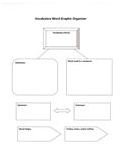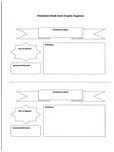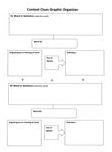Vocabulary Graphic Organizers: Ideas For Your Students
Improving Vocab
Vocabulary graphic organizers can help students at all levels develop their vocabulary. A student’s vocabulary level is a true test of
his or her reading level, which is ever so important for achievement test scores. Teachers need to try to improve and to expand students’ vocabulary through a variety of strategies and activities. A vocabulary graphic organizer can be an effective learning tool that teachers can easily integrate in their lesson plans.
Word Graphic Organizer
One way to improve understanding of vocabulary words is to have students complete the Vocabulary Word Graphic Organizer. In this lesson, the graphic organizer handout is included. The components of a graphic organizer that students need to complete on the Vocabulary Word Graphic Organizer are to define the word, use the word in an original sentence, find a synonym and antonym, identify the word’s origin, and break the word into prefixes, roots and suffixes.
This graphic organizer can be used for a short vocabulary word list. Asking students to fill out more than 10 Vocabulary Word Graphic Organizers might be considered torture for many students. Students could be placed in pairs, and do half the words each and study together. Or each student could complete two words on a longer list, and then share their knowledge in class during a study session. The graphic organizer will help students to have a deeper understanding of the words and this in turn will help the students to

remember the words better.
Vocabulary Study Cards Graphic Organizer
The Vocabulary Study Cards Graphic Organizer is included in this lesson. The graphic organizer can be turned into study cards for individual students when completed. Elementary teachers may want to copy the cards on tag board or more substantial paper. Students can also color or decorate the cards. The more time spent working with the completed cards, the better the chance the students will remember the words and the definitions.
There are two “cards” per page. Older students can cut them in half after they fill in the information and put them in a pocket folder. Teachers of younger students can cut them ahead of time and hole punch them so that they do not become lost. The cards can be locked into a three ring binder or placed on metal rings.
On the cards, the students need to write the vocabulary word. Students will need to look up the part of speech, a synonym, an antonym, and the definition. While students fill these out for each word, they will be improving their dictionary usage skills. When the cards are complete, students can study the cards with friends and family members.
Many students struggle with context clues. It is a great strategy to figure out word meanings on standardized and achievement tests.

Actually, it is a crucial skill that students need to develop. Beyond prodding students to read as many books as students can get their hands on to improve student vocabulary, teachers can use the Context Clues Graphic Organizer.
Context Clues Graphic Organizer
The Context Clues Graphic Organizers asks students to write the sentence in which the unfamiliar word appears. Students should then underline the word. Then, they need to write the word in a central section on the graphic organizer. Students should first guess or predict what they think the word means from the sentence and the use of context clues.
Next, students need to look up the word’s part of speech and definition. Students need to be careful when they write down the part of

speech on the graphic organizer. Sometimes, words can be used as a noun, verb and/or adjective. The definition the students write down should match the word’s usage in the sentence.
On the Context Clues Graphic Organizer there are places for two words. Teachers can give students three copies of the graphic organizer before they begin a novel. The students should complete the graphic organizer for words they do not know. When students finish a reading assignment, teachers can ask for students to share their Context Clues Graphic Organizer. The students and teachers can develop a vocabulary list from their discussions for a list. Students will have helped develop a vocabulary list and probably are feeling comfortable with several of the words on the list because the words came from their own lists.
Many types of graphic organizers are available for teachers to use with their students, and vocabulary graphic organizers are just one kind. There are graphic organizers for writing, reading, math, social studies, research, etc. They are great learning tools for students to organize information. In addition, graphic organizers are also a great help to students with visual impairments.
This post is part of the series: Graphic Organizers
The articles in this series will explain and give ideas on how to use graphic organizers.
